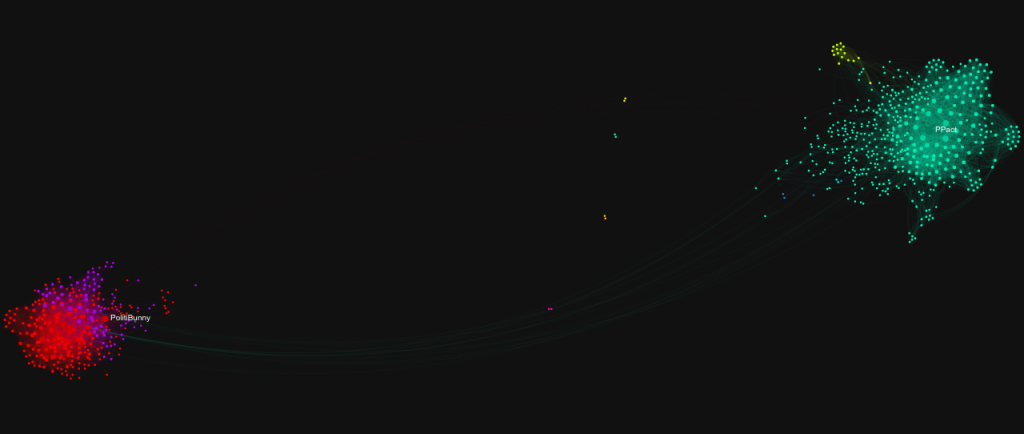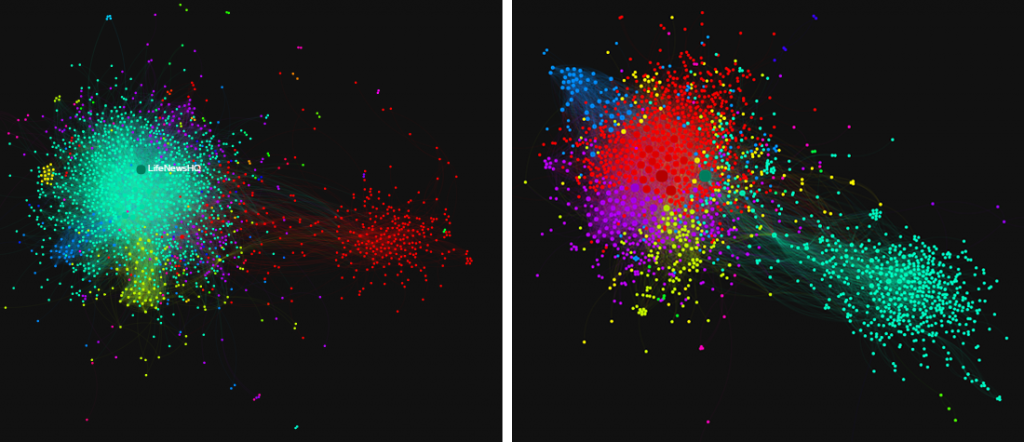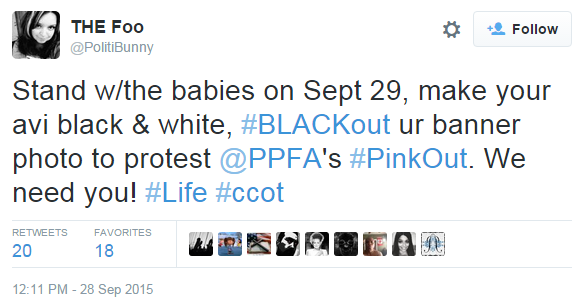On September 29th, 2015, Planned Parenthood organized a #PinkOut hashtag, to give Twitter users a forum in which to show support for the group. However, data collected with the #PinkOut hashtag shows one of the most polarized co-retweeted networks we have collected on TwitterTrails, far more polarized than even US electoral debates!

Attempting to undermine #PinkOut, some Twitter users opposed to Planned Parenthood suggested their own hashtag: #BlackOut. On the 28th, @PolitiBunny tweeted: “Stand w/the babies on Sept 29, make your avi black & white, #BLACKout ur banner photo to protest @PPFA’s #PinkOut. We need you! #Life #ccot”
Thus, a Twitter “war” of attention was waged; or rather, another “battle” in a long standing social media feud. This blog post explores the polarization in the network, and the two opposing hashtags.
In light of recent controversy and conservative attempts to defund Planned Parenthood, the organization announced a #PinkOut day for September 29th. The earliest tweets advertising this event are from mid-September. People were encouraged to wear pink (in person and online) and go to rallies to show their support of Planned Parenthood. The hashtag #PinkOut was trending on Twitter on the morning of the 29th, and #StandWithPP trended later the same day.
On September 29th at 10am, right in the middle of the pre-announced “attack”, we collected 25,000 tweets using the hashtag #PinkOut. The story can be explored in detail on TwitterTrails: http://twittertrails.wellesley.edu/~trails/stories/investigate.php?id=126641638.
The co-retweeted network (that shows the more prominent users, those whose messages have been retweeted by at least two others) is available for download on figshare: http://figshare.com/articles/_PinkOut_Co_Retweeted_Network/1559139.
Two Large Components in the Co-Retweeted Network

The co-retweeted network for the #PinkOut data is extremely polarized, to the point of being composed of two distinct large components. These tightly knit components have only a handful of edges between them, indicating that there were very few people that would retweet messages from both of the “camps”.
Compare this to other co-retweeted networks for previous Planned Parenthood stories:

These two networks are also polarized, but nowhere near to the degree of the #PinkOut network. The debate about Planned Parenthood has been raging on Twitter since the releases of the videos of Planned Parenthood doctors discussing selling fetal organs, but the discussion around #PinkOut was especially polarized.
With the Co-Retweeted Network Statistics module on TwitterTrails, we can explore these two communities in detail.
The blue community on the right is the larger of the two, with 450 nodes, while the community on the left is made up of two smaller, though still fairly connected communities in red and purple, 280 users combined. Co-retweeted networks tend to group similar users together, and looking at the most common words in the bios of users in the two communities, we get a very clear picture of why the network is polarized:

The divide in the discussion becomes obvious when looking at the bios of the users involved: one community is made up of users identifying as feminists, advocating for women’s healthcare, rights and reproductive rights. The other community is made up of two groups of similar users identifying as conservative, Christian or Catholic, and pro-life. Looking at the most common hashtags these groups use gives more insight.

The blue community supports Planned Parenthood, while the red and purple community opposes it. In addition, we see the #BlackOut hashtag in the conservative community. The polarization of these two communities results from their opposing views. Opinions on both sides of the debate are both politically and emotionally charged, so much so that there are barely any users who would retweet opinions on both sides.
These two communities dominate the network, and stand on opposing sides of the Planned Parenthood debate, which creates such a polarized network. Another contributing factor to the polarization is the absence of any accounts that are neutral in the debate, such as news media accounts reporting on it. News accounts tend to de-polarize networks, and bridge polarized communities by remaining unbiased and neutral in the discussion. They are more likely to be retweeted by both sides, whereas users posted strongly opinionated content are much more likely to be retweeted by someone who shares that opinion, and not by a user who differs in opinion.
#PinkOut vs. #BlackOut
Although we only collected data using the #PinkOut hashtag, tweets from the conservative community use the #BlackOut hashtag just as frequently. Activity in the #BlackOut hashtag rivals the #PinkOut hashtag for a while, as seen in the time series graph below.

Activity doesn’t pick up until the 28th, when @PolitiBunny wrote the previously mentioned tweet proposing #BlackOut as an effort to combat #PinkOut.

Conservatives attempted to undermine #PinkOut by hijacking the hashtag with their own #BlackOut hashtag. Their efforts were fairly successful as well, as seen by the activity of the two hashtags.
We can also look at the success the two communities had at spreading their opposing messages. Although the conservative community tweeted slightly more (2,300 tweets to 2,050), the liberal community has a higher spread: 51 compared to 45 by the conservative community. The activity of #PinkOut also clearly overtakes #BlackOut on the 29th, and #StandWithPP was trending later in the day.
Explore the story for yourself on TwitterTrails:
http://twittertrails.wellesley.edu/~trails/stories/investigate.php?id=126641638